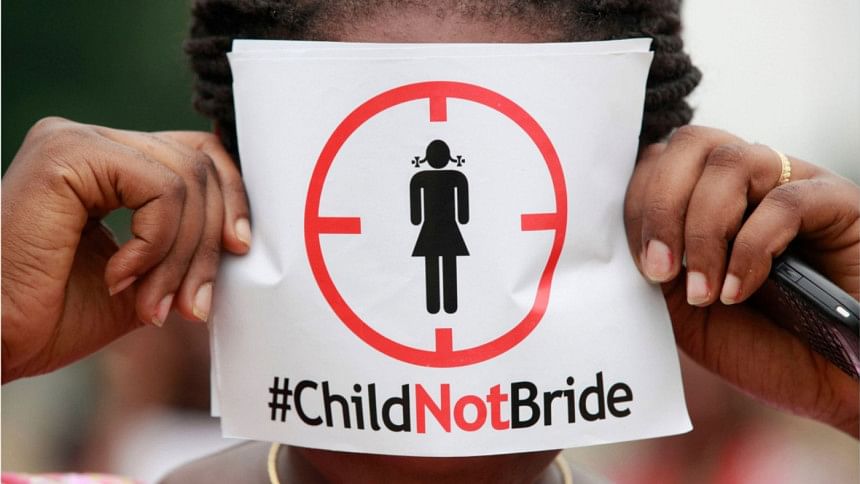How effective is the law restraining child marriage?

The demand of girls worldwide to live free from the harmful practice of child marriage is one of the key focuses of this year's International Day of the Girl Child. Bangladesh has committed to eliminating child marriage by 2030 in line with the Sustainable Development Goals (SDGs). However, despite some signs of progress in recent decades, the child marriage situation in the country remains alarming, with Bangladesh having one of the highest prevalence of child marriage in the region.
Although many factors interact to place a child at risk of marriage, an inadequate legislative framework plays a crucial role in perpetuating the practice and decelerating the progress of policy efforts. Bangladesh set up a new legal regime by enacting the Child Marriage Restraint Act 2017 and its corresponding Rules in 2018, replacing the old Act of 1929. The new Act, no doubt, introduced certain effective provisions which, if properly implemented, can positively contribute to the prevention of child marriage in Bangladesh. Nevertheless, there are several areas where the law lacks clarity, and the Rules also does not address those loopholes.
Retaining the previous legal position, the 2017 Act prescribes 18 for girls and 21 for boys as the marriageable age. However, such unequal marriageable age between males and females is not only discriminatory, it also creates some significant legal anomalies in the enforcement of the law. For example, if an adult woman of 18 years marries a man of 20 years, it will still be considered as "child marriage" (as one party is below the marriageable age), and the woman will have to face penal sanctions applicable for an adult contracting party under the Act—which is unreasonable, to say the least.
Discontent among the civil society actors was quite evident when the law retained the much-debated "special provision" allowing child marriage with courts' permission. It was expected that the Rules adopted in 2018 would substantially restrict the scope of application of the special provision; it nevertheless failed to do so. The Act and the Rules do not mention anything about the requirement for obtaining consent of the minor in an application under the special provision, neither does the Act provide any guideline or criteria to the courts in order to determine a child's "best interest". There is also no minimum age mentioned for allowing the exemption under the special provision.
Another significant problematic area in the 2017 Act is that although the law refers to the minor involved in a child marriage as a "victim" or "aggrieved person", it imposes penalty on minors for contracting child marriage (up to one month's detention and a fine of Tk 50 thousand). The law thus clearly creates contradictions by imposing criminal sanctions upon the victims whose interests it aimed to protect.
The 2017 Act is also silent about giving an option of annulment of the marriage if the minor so wishes. A victim of child marriage would have to follow the procedures prescribed under applicable personal laws for dissolution of the marriage, which are often discriminatory in application and can be quite difficult to access for a minor victim of child marriage.
Besides, the 2017 Act introduced a new provision of release of an accused person upon signing of an affidavit or bond stating simply that he will not be involved in child marriage in the future and will take initiatives to prevent child marriage in his locality. The Rules does not provide any details as to how the accused's participation in child marriage preventive initiatives can be monitored to ensure accountability against future violations. Thus the presence of such a provision may undermine the purpose of the law to deter child marriages by imposing criminal sanctions.
The Act also makes provision for issuance of injunction by the court. However, neither the Act nor the Rules clarifies which court would be able to issue such injunction. Similarly, for the application of the special provision, the law is silent regarding the court that may have jurisdiction to hear such application for special permission. There are also inconsistencies in the law in terms of exercise of jurisdiction by the Mobile Courts in intervening in a child marriage.
Other than the 2017 Act, one of the most challenging gaps with regard to child marriage is the law that allows rape of a girl child who is 13 years or above, if the child is married to the perpetrator. This is as per section 375 of the Penal Code of 1860 which defines and punishes rape. The definition given in the Penal Code is still applicable. Although we had enacted a separate law in 2000 for prosecuting violence against women and children related cases, the law chose to remain silent on such an archaic provision. The 2017 Act also does not address the issue of rape of a child bride. This is clearly contradictory to Bangladesh's international commitment to protect a girl child from sexual exploitation and could encourage the culture of forced marriage of a child rape victim with the offender.
The new legal regime for eliminating child marriage, thus, needs to be reviewed extensively. Keeping in mind that Bangladesh is committed to ending child marriage, it is critical to address the gaps in the new law and to introduce effective monitoring over its implementation at all levels. Strengthening the laws would create clear benchmarks to address child marriage and would ultimately enable the policy efforts to succeed in preventing child marriage.
Taslima Yasmin is a legal researcher and teaches at the Department of Law, Dhaka University.
Email: [email protected]

 For all latest news, follow The Daily Star's Google News channel.
For all latest news, follow The Daily Star's Google News channel. 



Comments